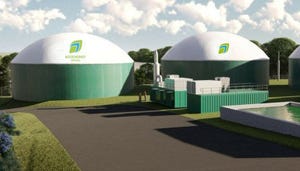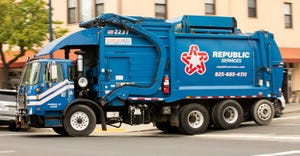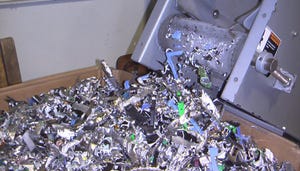Competition Drives: '97 Truck Lines
October 1, 1996
Bob Deierlein
As refuse truck manufacturers shoulder for the competitive edge with their '97 lines, knowledgeable haulers in the market will benefit. While some manufacturers promise reduced downtime due to easier serviceability and commonality of parts, others boast upped warranties, smoother dumping and easier maneuverability.
Look for aerodynamic designs, increased visibility and increased maintenance intervals. Driver safety and comfort also are highlighted features to expect in dealer showrooms. The following preview of the latest chassis, waste trailers and bodies will keep you abreast of industry changes as you weigh the options.
Bridgeport The automated side loaders from Bridgeport Truck Manufacturing Inc., Bridgeport, Texas, are designed with all-air operated controls and an automated packing cycle. They can be manufactured with an optional right-hand drive. The side loaders offer a complete one-year warranty (extended warranties are available); factory training and support; 8' 96" reach and 8 to 10 second cycle time. Custom-built bodies also are available.
Ford Ford Commercial Truck Vehicle Center, Dearborn, Mich., reported that its new Louisville Class 7 and Class 8 trucks offer a feature not often seen on fleet vehicles: a durable, lightweight, corrosion-resistant aluminum cab. The cab's aluminum panels are targeted to weigh less than 300 pounds.
In addition, the company announced that the F-Series medium-duty truck is now available with a Ford-built 4-door crew cab, which incorporates all the anti-corrosion, durability and paint quality features of conventional Ford truck cabs.
Freightliner Freightliner Corp., Portland, Ore., offers its Business Class heavy-duty truck platform for refuse applications. The Business Class 70 Series conventional refuse chassis is designed for high visibility, ease in entrance and exit and one-step entry.
Other features include a set-back front axle and 50 degree wheel cut for maneuverability. The tilt fiberglass hood gives engine and radiator accessibility without tilting the cab. The galvanized cab structure is zinc-coated for corrosion protection. Inside the cab, the electrical center's wiring pigtails are positioned along the frame rails, which facilitates the body's electrical installation. All 70 Series engines are governed to maintain constant engine rpms during PTO operation.
Another recent introduction, the Century Class family, claims safety, fuel/weight efficiency, reliability and low maintenance costs. This group includes day cab versions in 112" and 120" bumper-to-back-of-cab (BBC) lengths in a range of midroof and raised roof models.
Warranties are upped from the "standard." For example, Century Plus includes the basic 3 years/300,000 miles; 5 years/500,000 miles on the cab structure and sheet metal; 5 years/ 750,000 miles on the drive-train components and 6 years/750,000 miles on frame rails and cross members.
The Century Class interior is five inches wider in front and 10 inches wider in the B-pillar area. Door openings also are wider, and the steering wheel and steps are positioned for safer access.
This class offers new front cab mounts and rear- cab, air ride suspension, improved engine mounts and a new front axle suspension.
The diesel engine is a newly-developed Detroit Diesel Series 55 engine, exclusive to Freightliner. This engine is standard with the 112" BBC models and an option on 120" BBC models.
Time to overhaul the engine is projected to be 750,000 miles. Its warranty is for 2 years/unlimited miles, 100 percent parts and labor; major castings and forgings are warranted for 100 percent parts for five years or 500,000 miles.
GMC/Pontiac GMC/Pontiac-GMC Division, Pontiac, Mich., has introduced the T-Series, an all-new tilt cab truck.
The company explained that if a truck ends up with a Class 6 GVW rating, it will be designated a "T-6500." Likewise, a Class 7 will be designated a "T-7500" and so forth.
The series has a sharp wheel turn and variable rations steering for handling in tight spaces. In addition, its set-back axle design allows more back-end capacity. This series can accommodate bodies up to 28' in length and payloads up to 40,000 pounds. GM's 6.0-liter gasoline V-8 is the standard engine. The Cat 3116 with ratings up to 275 hp will also be offered. Allison automatics is the base transmission.
Isuzu Changes abound with the 1997 models at American Isuzu Motors Inc., Whittier, Calif. The Class 6 FSR and Class 7 FTR and FVR are powered by an Isuzu 6HE1-TC diesel engine in two horsepower configurations.
The FSR has a base GVWR of 23,100 pounds and the 200-hp 6HE1-TC diesel; the FTR has a base GVWR of 25,950 pounds and 30,000 pounds with the same engine. The FVR has a base 33,000 pound GVWR and the same engine at 230 hp.
The FSR, FTR and FVR models feature an all-new cab-forward design.
Kenworth The first two configurations of the T2000 from Kenworth Truck Co., Kirkland Wash. - a 120" and a 112" BBC model - are currently available. Two new models are scheduled for mid-'97. The new trucks' engines include: up to 550-hp on the 120-inches BBC models, and 11- and 12-liter engines on the 112" model.
The weight benefit is in the hundreds of pounds over the T600 with a 72-inch AeroCab. The biggest savings is the 400-pound difference between the new Airglide 200 and Airglide 100 air suspension systems.
In addition, the T2000 has 30 percent fewer parts compared to other KW models.
Labrie Labrie, Quebec, Canada, has introduced the Expert 2000. This side-loading packer has a 1.37 cubic yard hopper and a hydraulically operated backdoor. A crusher panel in the front wall provides downward pressure reducing refuse build-up behind the packer ram.
Other truck highlights include: a tracking system, located in the compactor house; packer-wear shoes that are replaceable without removing the compactor; and a rubber seal that prevents leakage and banging on the back of the body.
LoDal The EVO-Combo, a dual purpose, combination sideloader/recycler is manufactured by LoDal Inc., Kingsford, Mich. This one-pass waste/recyclables transporter compacts refuse or recyclables in a large, side loading, high compaction body and provides two side dumping bins that are forward and aft of the main compaction hopper.
The size of the body ranges from 16, 19 or 21 cubic yards, depending on the rear recycling bin's size, which is offered in six, eight or 12 cubic yards.
Mack Mack Trucks, Allentown, Pa., builds a low-entry chassis model available in a 6x4 configuration for front loaders. For recycling operations and rear loaders with less capacity, the company has designed a 4x2.
Features include a tilt cab and dual steering with right-side, walk-in capabilities for curbside collection.
Maxon AutoMax from Maxon Refuse Products Inc., Hunting-ton Park, Calif., has a 12' reach, 1,000 pound capacity and operates at idle for continuous loading, even while packing. This automated side loader is a hydraulically-powered mechanism is designed to grasp, lift, dump and return round or square roll-out containers ranging in size from 32 gallons to 150 gallons.
AutoMax is equipped with self-leveling grips that keep containers level throughout the arc until reaching the hopper lip where the can is rotated to a 45 degree maximum dumping angle to discharge the load into the hopper's center. It uses either switches or single joy stick controls for operations. Normal operations are at engine idle, the transmission in "drive" to eliminate shifting.
The AM-36 features the AutoMax loading arm with a 12' reach, 1,000 pounds capacity, 6 to 10 second cycle times, 34- to 125-gallon container cart capacities and a universal self-leveling cart gripper.
It is produced in full-eject and half-pack dump style bodies. The packer blade features a full follower panel for continuous dumping into the receiving hopper.
Navistar Navistar International Transportation Co., Chi-cago, Ill., has given facelifts to International 9200 and 9400 model premium conventional tractors. Key areas to watch:
* chassis weight reduced by more than 300 pounds and increased availability of additional lightweight components;
* new hood;
* less costly repair required;
* chassis share parts commonalty which enhances aftermarket support; new standard equipment and other components can act as added safety features and reduce maintenance costs; and
* engineering design and componentry's location reduces service time.
Weight savings are up to 308 pounds on the 9200, and 382 pounds on the 9400, due to new front suspension castings, frame and bumper systems, radiator and transmission mountings, cooling fan, and a new three- piece hood.
Long-life halogen headlights, daytime running lights and long-stroke brake chambers with increased adjustment intervals are standard. An extended fender protects the fuel tanks from road damage.
Hood-assisted springs and a hood-dampening hydraulic shock absorber help ensure a smooth, slow hood-falling motion.
Oshkosh High visibility is the aim with the NL-Series from Oshkosh Truck Corp., Oshkosh, Wis. These vehicles boast 3,500-square inch windshields, well-positioned side windows, low doghouses and a step-in height of 18".
Additionally, the optional right-hand drive position means no steps are wasted going around the truck to make the collection.
Oshkosh reports this series' cab and door openings as one of the largest in the industry. The air-operated work brake system keeps the truck in place during each pick-up.
Slip the work brake control lever back into the "off" position, and the transmission is shifted automatically into the last gear used. (A safeguard ensures that the transmission won't shift automatically into reverse.)
The electrical wiring is number-coded and function-stamped for identification; gauge modules can be independently removed for major sub-system servicing; the dash console design provides quick access to air and electrical connections and transmission shift control.
Pak-Mor Pak-Mor Manufacturing, San Antonio, Texas, manufactures the ASR400 Synthetic Container Handling Machine. The truck is fully automated and its unitized construction distributes lift force throughout the body, reportedly reducing stress and bending load on the chassis frame.
Peterbilt Peterbilt Motors, Den-ton, Texas, unveils its redesigned Model 377A/E. This version boasts a dramatically-sloped hood for increased visibility and improved aerodynamics. A new contoured, polished aluminum hood crown accents the styling while the stainless-steel grille provides improved engine compartment and radiator protection.
Other features: headlights with Lexan lenses which resist damage from rocks and road debris; a standard chromed, aerodynamic bumper, which conforms to the new hood profile; and an optional three-piece, composite bumper for simplified repairs.
Scranton The New Way II Series rearloaders are mid-ranged refuse compactors built by Scranton Manufacturing Co., Scranton, Iowa. Available in 9 cubic yards to 25 cubic yards, the rearloaders' feature low pressure hydraulic systems, 2.5 cubic yard hoppers for municipal and residential pick-up, and low centers of gravity.
Packaging/ejection blades form the trucks' front, reportedly developing up to 850 pounds per cubic yard compaction.
Volvo Volvo GM Heavy Truck Corp. Greensboro, NC, introduces the Volvo VN Series, a new family of tractors. The series is available in two BBC dimensions: a 113" medium conventional and 123" long conventional. Either BBC length is available with single or tandem axle configurations.
Improvements in the VNs include the 18-degree-sloped hood, a large, one-piece windshield and a new mirror system. The cab material is High Strength Steel (HSS).
The series cab is 89" wide at the B-pillar, and is 4" taller, 5" deeper and 6" wider than previous models. The hydraulically-actuated clutch means the driver's pedal effort is only 40 pounds.
The VN is designed to reduce interior noise level. Doors have two seals, floor insulation is 1" thick and the shifter boot covers the entire stick.
For normal on-highway applications, the basic coverage is 36 months/350,000 miles. All specifications and applications receive a 72-month/750,000-mile frame and cross-member warranty, a 72-month/750,000-mile cab structure warranty and a 96-month/one-million-mile cab corrosion warranty. A 72-month/one-million-mile cab structure warranty also is available.
Finally, new models of the Volvo VE D12 diesel engine include:
* The VE D12-345, the standard diesel engine in the series, rated 345 horsepower (hp) at 1,300-1,700 rpm and 1,350 pound/foot of torque at 1,100-1,300 rpm. Each also can be specified with a 10-, 11-, 12- or 14-liter engine ranging from 280 to 550 hp from Volvo, Cummins, Detroit Diesel or Cater-pillar. The models are rated 345-, 385-, and 425-hp.
* The VE D12 is a 6-cylinder, in-linediesel engine, featuring turbocharging and air-to-air intercooling. Its dry weight is 2,337 pounds, and has a B50 rating of one million miles.
VE D12s are backed by a 24-months/250,000-miles warranty with an optional 5-year/500,000-mile warranty covering parts and labor on major components.
Volvo also offers a 5-year/500,000-mile extended warranty which covers parts and labor on almost all engine components.
Wayne Wayne Engineering Corp., Cedar Falls, Iowa, manufactures the Super Series - six and eight cubic yard rear-loading refuse bodies. The trucks' narrow width (78 inches) and low height allows them to pass under low doorways and into narrow alleys where larger packers can't go, according to the company.
The rearloaders can hold more than 700 pounds per cubic yard and feature a 10 second cycle time. Perfect for parks, resorts, trailer courts, and rural routes where maneuverability and payload are important.
Like everything else in the truck business, spec'ing a suspension isn't what it used to be. Contrary to the old "one size fits all" mentality, experts advise that today's truck suspension should be spec'ed like you are custom designing it.
The first step is to define the specific needs of your application, then find the suspension that will meet those needs. For example, the requirements for a front-end loader's suspension are different than those of a tractor-trailer combination and even rear loaders.
Once defined, specific application information must be provided to the suspension supplier or truck dealer when purchasing a new truck.
Suspensions come in a variety of configurations. Some trucks may require suspensions that balance stability, durability and ride, while others may have more narrowly defined needs.
You don't necessarily have to compromise if you need a combination of these qualities. For example, in the past, some truckers shunned lighter weight suspensions, but like everything else, that's changing, too.
The emphasis today is on increased payload, excellent stability, minimal scheduled maintenance and a superior ride for both driver comfort and equipment protection, according to Frank Stevens from Hendrickson. "Today's lighter weight suspensions surpass expectations of durability and still provide excellent stability in partially loaded or empty trucks," he said.
And with continued enforcement of state axle weight regulations, haulers are turning to the self-steering tag axles to spread the load, Stevens noted. "Since it is difficult to add one afterwards on most refuse vehicles, you should seek sound advice when originally spec'ing the unit," he suggested.
Of course, price is always an issue in spec'ing a suspension system. But haulers should consider life cycle cost as well as just first cost. Life cycle cost considers initial costs, plus maintenance costs over the life of the truck or trailer, plus resale or trade-in value.
Life cycle cost considerations can be substantial, and often an upgrade to a slightly more expensive suspension can pay for itself early in the life of the vehicle, particularly in equipment maintenance.
Finally, consider the suspension manufacturer's track record. Do they build a quality product? Will they support you in the field with technical service? Do they know your business? Are they innovators and problem solvers? Will they continue to be in business to stand behind their products?
What is an NTEP certified scale? NTEP are the scale testing rules adopted by the National Institute of Standards Technology (NIST), which focuses on tamper proofing a scale, insuring both accuracy and longevity.
In practice, if you're buying or selling anything weight-based in the United States, the scale must be approved "legal for trade." Each state's weights and measures department tests the scale for this certification. Every installation of an NTEP certified scale design must undergo field tests, which begins with a battery of tests of the truck-mounted scale.
The scale electronics and calibration then is sealed, allowing no adjustments. A month later, the weights and measures department re-examines the scale, using the same set of tests. These tests measure increasing and decreasing loads, off-center loading, rounding verification and off-angle testing. An in-motion or dynamic bin scale certification includes a series of tests which examine the accuracy of each load dumped. Failing any test ends the certification process.
The tests take between eight and ten hours, and use several testers and a weight truck with a crane.
The accuracy requirements of an NTEP scale is expressed in divisions. For example, a front end loader bin scale must be accurate to within 1/500 of its capacity. So, a 10,000-pound front end loader scale must be accurate to within plus or minus 20 pounds. For initial certification, NIST requires that the scale perform twice as well, or plus and minus 10 pounds for a 10,000-pound bin scale.
In addition, a scale may not indicate or record weight which is below 20 times the division size, according to NTEP's 20d rule. This means that a certified scale could not show weight below 400 pounds (20 x 20 pounds) using a 10,000- pound bin scale.
Should you buy a scale certified legal for trade? You must, of course, if you're using the truck's bin scale to charge by the pound. Even in non-legal for trade applications, the certified design implies at least a 30-day life and capability of accuracy within its division.
Remember, attaining and maintaining this certification costs money, including:
* tests for each installation, since the scale's accuracy also depends on the installation's quality;
* extra equipment and/or the labor necessary; and
* additional service or maintenance costs, because once a certified scale seal is broken, certification testing must be redone.
Unlike earlier models, bin scales are available today which only require maintenance once or twice a year and deliver accuracy close to an NTEP certified scale at less cost.
You May Also Like


